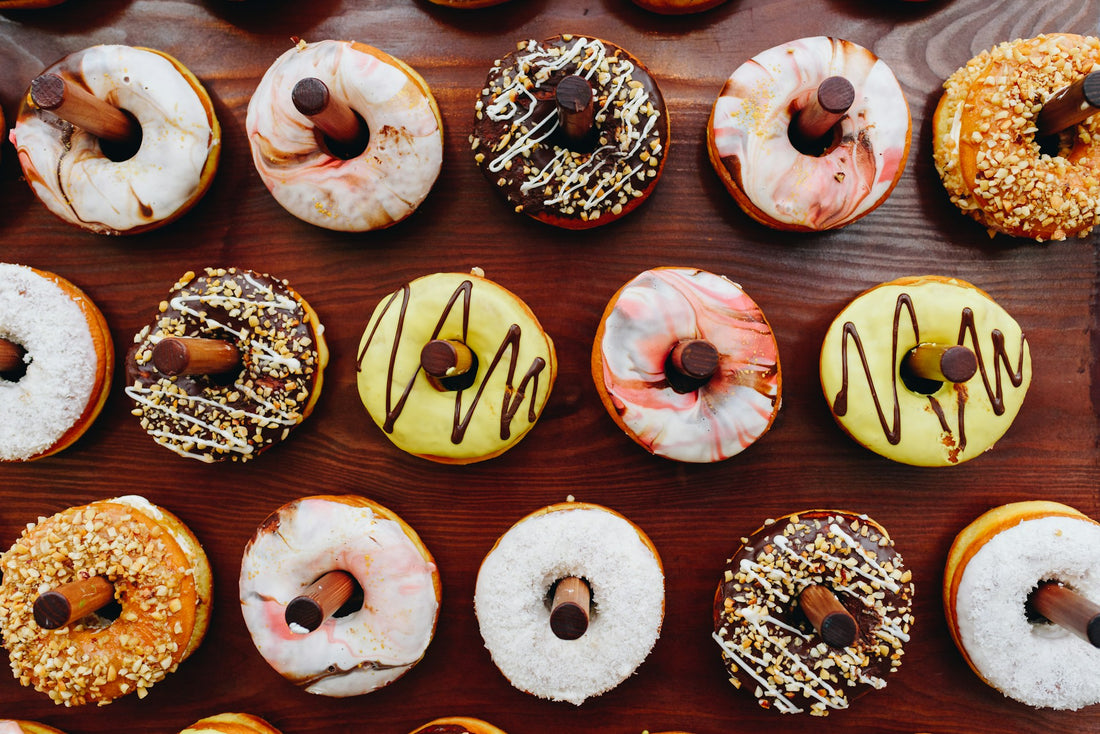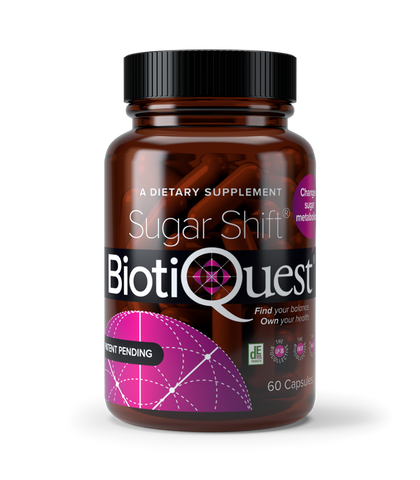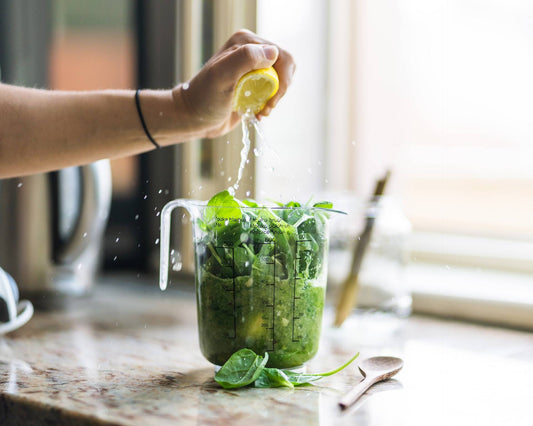

Do you constantly crave sugar? Do you reach for sugary foods despite your best efforts to resist sugar cravings? Are you constantly searching for ways to reduce sugar cravings?
The answers you’ve been looking for - ways to reduce sugar cravings - might just lie within your gut. In this article, we explore your gut microbiome's fascinating role in influencing your sweet tooth, delve into the science behind probiotics, and how you can support your gut health by adding fermented foods, plus the best probiotic for sugar cravings.
What are sugar cravings?
A sugar craving is a persistent desire to eat something sweet. Strong sugar cravings can become difficult to overcome since every time you consume sugar, your brain and your gut microbes (more on that later) reward1 you with dopamine, the feel-good hormone.
Need Vs Pleasure
Most often we begin a meal in response to biological cues such as feeling hungry in response to hunger hormones such as ghrelin and we end2 a meal based on ‘feeling full’.
Hormones like insulin, leptin, glucagon-like peptide 1 (GLP-1), and peptide YY (PYY), released in response to cues such as blood sugar as well as sugar, fat, and protein in the gut, signal a feeling of fullness that induced us to stop eating.
Some commercial anti-diabetic medications contain3 Semaglutide, which is a GLP-1 agonist. An agonist is a drug or substance that attaches to specific receptors in the body to perform a unique function. For instance, Semaglutide attaches to the same receptors in the body as GLP-1 and induces similar satiety and insulin-stimulating actions as GLP-1 might.
The optimal release of satiating hormones such as GLP-1 and PYY is dependent4 on bacterial metabolites that result from a healthy microbiome. A conflict in energy homeostasis may occur when eating for pleasure (reward signaling) begins to override5 eating to maintain optimum energy (satiety signaling).

(Figure 2, Zeng et. al., 2024)
What sustains sugar cravings?
To ensure survival, your brain has learned to reward1 you (reward includes learning, wanting, and motivation) for consuming calorie-rich foods. Back in the day, when you found and ate nutrient-rich sweet berries, your brain released dopamine.
Dopamine is a hormone that is associated1 with not only pleasure but also motivation, learning, and memory - to help you remember how you got to the berries so that you’ll be able to do it again and anticipate consuming them in the future.
A regulated and healthy reward response intermingles food-seeking and eating experiences into a pleasant experience whereas a dysregulated reward response, either too much or too little dopamine, can alter1 the experience and the after-effects of food-seeking.
For instance, a study6 exploring the effects of dopamine on mice eating behaviors found that mice with a dopamine deficiency starve to death, if not supplemented with dopamine.
A dysregulated reward system, fructose, and dysbiosis
On the other end of this spectrum is the release of too much dopamine in response to highly palatable foods. Every time you consume a highly palatable food, the brain first rewards1 you when the taste receptors recognize the sweetness, and then another release of dopamine hits when gut sensors recognize the presence of sugar in the gut. This cycle of dysregulated eating can become further exacerbated with gut dysbiosis and an increase in sugar-loving bacteria.
Refined sugar in the form of high fructose corn syrup (HFCS) is the mainstay in most convenience foods and sugary drinks. Research studying7 the effects of HFCS on the gut microbiome suggests that high fructose diets encourage the growth of gram-negative bacteria such as Proteobacteria that can outcompete beneficial bacteria in the gut leading to an imbalance in the gut microbiome associated with inflammation and disease.
Apart from developing health concerns such as high blood sugar levels, type 2 diabetes, trouble with weight management, and heart disease, giving into sugar cravings might also contribute to a negative mental health cycle.
But here’s the kicker: sugar cravings aren’t as simple as mind over matter, and here’s why.
Gut health and sugar cravings
Gut bacteria play a pivotal role in maintaining optimal health. Gut microbes need us for shelter and food and in turn, provide us with metabolites (microbial by-products) that are necessary for our wellbeing.
A wide range of studies8 emphasize that an increase in the abundance of unhealthy gut bacteria and the lack of overall gut microbial diversity is associated9 with concerns such as metabolic disorders, mood regulation, depression, obesity, anxiety, and cardiovascular risks. An abundance of healthy bacteria over bad bacteria translates to good gut health and metabolic homeostasis.
There are different communication pathways between the gut and the brain called the microbiome-gut-brain axis, and learning about them is key to understanding how your gut health might contribute to reducing sugar cravings.

(Figure 1, DeGruttola et al., 2016)
The Microbiome Gut-Brain Axis
The enteric nervous system (intestinal nerves) and the vagus nerve can send and receive instantaneous signals to and from the brain about the state of nutrients in the gut via10 sensor cells called neuropods and your brain responds to this communication by executing decisions regarding seeking, intake, and cessation (limiting) behaviors.
Different communication channels - neuronal signaling through neuropods and neurotransmitters via the vagus nerve, endocrine signaling (hormones and gut peptides), and immune system signaling (cytokines), and bacterial signaling via metabolites - combined form the microbiome gut-brain axis.
Dysbiosis and bacterial metabolites
An imbalance in the gut environment might result in a decrease11 in beneficial bacteria like Bifidobacterium spp., F. prausnitzii, Lactobacillus., etc, that can alter the optimum synthesis of bacterial metabolites such as short chain fatty acids (SCFAs) that might help you reduce sugar cravings.
In addition to alterations in SCFA synthesis, dysbiosis can also lead to an increase12 in endotoxins such as lipopolysaccharides (LPS) and flagellins due to bacterial overgrowth like Proteobacteria.
Excessive circulating endotoxins have been associated13 with compromised gut barrier function, a leaky gut, and low-grade chronic inflammation.
Fructose and an increase in sugar-craving bacteria
In a study8 performed in rats, fructose consumption led to an increase in Coprococcus and Ruminococcus, bacterial strains that have been associated with inflammation.
In another instance, infections from bacteria such as Trichinella spiralis can decrease the desire to eat while a decrease in gut bacteria-driven serotonin synthesis and a decrease in serotonin signaling has been associated15 with binge eating.
The magic of molecular mimicry in inducing sugar cravings
Gut microbiota can produce amino acid sequences similar to neuropeptides our body makes to regulate emotion and appetite.
For instance, Neuropeptide Y is one of the strongest hunger-inducing hormones and specifically increases your appetite for carbohydrates. Bacteroides produce molecules that mimic16 insulin, neuropeptide Y (NPY), and melanocyte-stimulating hormone (a-MSH) and thus can impact and trick our brain into craving sugar.

(Figure 1, García-Cabrerizo et al., 2021)
The impact of bacterial metabolites on reducing sugar cravings
Upon digestion, the macronutrients attach to sensors in the gut allowing for nutrient absorption and release of satiety hormones such as GLP-1 and PYY from specialized intestinal endocrine cells, called the L cells.
Short chain fatty acids (bacterial metabolites) attach to receptors on L cells and are suggested 4 to stimulate the release of GLP-1 and PYY. The release of GLP-1 and PYY further stimulates a cascade of satiety hormones such as insulin and leptin responsible for reducing sugar cravings.
How do SCFAs act on the brain to stop sugar cravings
Each satiety hormone attaches to different receptors in the brain and leads you to feel less interested in food. Studies support 12 that supplementation of GLP-1 helps reduce sugar cravings without suppressing the intake of standard food.
In addition to GLP-1, the release of Peptide YY is also influenced by the generation of SCFAs. Studies found12 that systemic administration of PYY inhibits food intake in rodents and humans, altering the neuronal activity of reward-specific brain centers (VTA) in human volunteers.
The optimum release of GLP-1 and PYY is dependent on adequate SCFA availability, which in turn is dependent on a healthy gut microbiome.
Reducing sugar cravings with a healthy gut
Nutrient competition17, cross-feeding, and inhibiting the growth of competitors form the basis of a healthy gut microbiome.
A healthy gut microbiome thrives on a healthy diet that includes prebiotics such as dietary fiber and resistant starches present in green bananas, cooked and cooled potatoes, non-GMO and glyphosate (pesticide) free oats, etc. At the same time, excess sugar consumption leads to an overflow of unabsorbed fructose and sucrose to the large intestine where it becomes available as a growth medium to a wide variety of pathogenic bacteria.
Excessive fructose consumption has been associated with a decrease in SCFA production and an increase8 in the abundance of gram-negative bacteria, which leads to an increase in LPS.
Increasing beneficial bacteria to curb sugar cravings
Whole foods including greens, seasonal fruit, and vegetables; healthy fats such as olive and coconut oil, pasture-raised animal fats like butter and lard; and protein in addition to fermented foods make for a balanced diet that protects you from nutrient deficiencies. Consumption of healthy proteins and fats - highly satiating macronutrients - might help you curb sugar cravings and maintain gut microbiome diversity.
Probiotic-rich foods such as unsweetened kombucha, kefir, kimchi, sauerkraut, yogurt, etc., introduce a host of probiotic bacteria such as Lactobacillus, Bifidobacterium, Bacillus, Pediococcus to your gut environment. Probiotic bacteria such as Leuconostoc mesenteroides convert excess sucrose and fructose molecules into mannitol further acting as a prebiotic for the growth of SCFA-producing bacteria.
Try out my ‘super gut’ probiotic yogurt and beet kvass recipes for the perfect blend of taste and probiotic goodness!
Effects of herbicides and additional factors on gut health
In addition to choosing whole foods to make up the bulk of your diet, be mindful of herbicides, pesticides, and additional alterations that might have been made to make your foods last longer.
Herbicides such as glyphosate have been associated18 with altering gut flora diversity with a whopping 54% of gut bacteria being sensitive19 to its impact.
In addition to a healthy diet, Dr. William Davis in his book Wheat Belly20 suggests that to improve gut health and avoid the increasing risks of prediabetes and type 2 diabetes, you will want to reduce sugar and stop consuming certain foods (wheat and other grains) as they lead to persistent high blood sugar and insulin resistance.
Sugar cravings and probiotic supplement
One of the most sustainable ways of reducing sugar cravings is by introducing a wide range of probiotic microbes into the gut microbiome that might help out-compete bad bacteria. Eating whole foods rich in prebiotics will not only increase the abundance of probiotics in the gut but also provide postbiotics such as short chain fatty acids and neurotransmitters which directly impact how satisfied you feel after a meal.
 Besides fermented foods, adding in probiotic supplements like SugarShift and Ideal Immunity™ can be a great way to add in beneficial bacteria:
Besides fermented foods, adding in probiotic supplements like SugarShift and Ideal Immunity™ can be a great way to add in beneficial bacteria:
Sustained improvements in diet with the help of nutrient-dense foods and probiotic supplements are a surefire way of getting those pesky sugar cravings under control. Not only does a healthy gut translate to a healthy body but it might also help your mind be more at ease.
Are you curious about how your gut health might influence your mental health? Find out more about the secrets of happiness from belly to brain.
References
- Edwin Thanarajah, S. & Tittgemeyer, M. (2020). Food reward and gut-brain signalling. Neuroforum, 26(1), 1-9. https://doi.org/10.1515/nf-2019-0020
- Alonso-Alonso, M., Woods, S. C., Pelchat, M., Grigson, P. S., Stice, E., Farooqi, S., Khoo, C. S., Mattes, R. D., & Beauchamp, G. K. (2015). Food reward system: Current perspectives and future research needs. Nutrition Reviews, 73(5), 296-307. https://doi.org/10.1093/nutrit/nuv002
- Mahapatra, M. K., Karuppasamy, M., & Sahoo, B. M. (2022). Semaglutide, a glucagon like peptide-1 receptor agonist with cardiovascular benefits for management of type 2 diabetes. Reviews in Endocrine & Metabolic Disorders, 23(3), 521-539. https://doi.org/10.1007/s11154-021-09699-1
- Zeng, Y., Wu, Y., Zhang, Q., & Xiao, X. (2023). Crosstalk between glucagon-like peptide 1 and gut microbiota in metabolic diseases. MBio, 15(1), e02032-23. https://doi.org/10.1128/mbio.02032-23
- Avena, N. M., Rada, P., & Hoebel, B. G. (2008). Evidence for sugar addiction: Behavioral and neurochemical effects of intermittent, excessive sugar intake. Neuroscience and Biobehavioral Reviews, 32(1), 20. https://doi.org/10.1016/j.neubiorev.2007.04.019
- Szczypka, M. S., Kwok, K., Brot, M. D., Marck, B. T., Matsumoto, A. M., Donahue, B. A., & Palmiter, R. D. (2001). Dopamine Production in the Caudate Putamen Restores Feeding in Dopamine-Deficient Mice. Neuron, 30(3), 819–828. https://doi.org/10.1016/S0896-6273(01)00319-1
- Guney, C., Bal, N. B., & Akar, F. (2023). The impact of dietary fructose on gut permeability, microbiota, abdominal adiposity, insulin signaling and reproductive function. Heliyon, 9(8), e18896. https://doi.org/10.1016/j.heliyon.2023.e18896
- DeGruttola, A. K., Low, D., Mizoguchi, A., & Mizoguchi, E. (2016). Current understanding of dysbiosis in disease in human and animal models. Inflammatory Bowel Diseases, 22(5), 1137. https://doi.org/10.1097/MIB.0000000000000750
- Carding, S., Verbeke, K., Vipond, D. T., Corfe, B. M., & Owen, L. J. (2015). Dysbiosis of the gut microbiota in disease. Microbial Ecology in Health and Disease, 26. https://doi.org/10.3402/mehd.v26.26191
- García-Cabrerizo, R., Carbia, C., O´Riordan, K. J., Schellekens, H., & Cryan, J. F. (2021). Microbiota-gut-brain axis as a regulator of reward processes. Journal of Neurochemistry, 157(5), 1495–1524. https://doi.org/10.1111/jnc.15284
- Nogal, A., Valdes, A. M., & Menni, C. (2021). The role of short-chain fatty acids in the interplay between gut microbiota and diet in cardio-metabolic health. Gut Microbes, 13(1). https://doi.org/10.1080/19490976.2021.1897212
- Kim, H. soo, Kim, S., Shin, S. J., Park, Y. H., Nam, Y., Kim, C. won, Lee, K. won, Kim, S.-M., Jung, I. D., Yang, H. D., Park, Y.-M., & Moon, M. (2021). Gram-negative bacteria and their lipopolysaccharides in Alzheimer’s disease: pathologic roles and therapeutic implications. Translational Neurodegeneration, 10(1), 49. https://doi.org/10.1186/s40035-021-00273-y
- Kaelberer, M. M., Rupprecht, L. E., Liu, W. W., Weng, P., & Bohórquez, D. V. (2020). Neuropod Cells: The Emerging Biology of Gut-Brain Sensory Transduction. Annual Review of Neuroscience, 43(Volume 43, 2020), 337–353. https://doi.org/10.1146/annurev-neuro-091619-022657
- Terry, S. M., Barnett, J. A., & Gibson, D. L. (2022). A critical analysis of eating disorders and the gut microbiome. Journal of Eating Disorders, 10(1), 154. https://doi.org/10.1186/s40337-022-00681-z
- García-Cabrerizo, R., Carbia, C., Schellekens, H., & Cryan, J. F. (2021). Microbiota-gut-brain axis as a regulator of reward processes. Journal of Neurochemistry, 157(5), 1495-1524. https://doi.org/10.1111/jnc.15284
- Horrocks, V., King, O. G., Yip, A. Y. G., Marques, I. M., & McDonald, J. A. K. (2023). Role of the gut microbiota in nutrient competition and protection against intestinal pathogen colonization. Microbiology, 169(8), 001377. https://doi.org/10.1099/mic.0.001377
- Gama, J., Neves, B., & Pereira, A. (2022). Chronic Effects of Dietary Pesticides on the Gut Microbiome and Neurodevelopment. Frontiers in Microbiology, 13. https://doi.org/10.3389/fmicb.2022.931440
- Puigbò, P., Leino, L. I., Rainio, M. J., Saikkonen, K., Saloniemi, I., & Helander, M. (2022). Does Glyphosate Affect the Human Microbiota? Life, 12(5). https://doi.org/10.3390/life12050707
- Dr. William Davis | Cardiologist & Author of Wheat Belly Books. (n.d.). Dr. William Davis Infinite Health. Retrieved August 29, 2024, from https://drdavisinfinitehealth.com/
- Rivière, A., Selak, M., Lantin, D., Leroy, F., & Vuyst, L. D. (2016). Bifidobacteria and Butyrate-Producing Colon Bacteria: Importance and Strategies for Their Stimulation in the Human Gut. Frontiers in Microbiology, 7. https://doi.org/10.3389/fmicb.2016.00979
- Luck, B., Horvath, T. D., Engevik, K. A., Ruan, W., Haidacher, S. J., Hoch, K. M., Oezguen, N., Spinler, J. K., Haag, A. M., Versalovic, J., & Engevik, M. A. (2021). Neurotransmitter Profiles Are Altered in the Gut and Brain of Mice Mono-Associated with Bifidobacterium dentium. Biomolecules, 11(8). https://doi.org/10.3390/biom11081091
- Strandwitz, P. (2018). Neurotransmitter modulation by the gut microbiota. Brain Research, 1693(Pt B), 128. https://doi.org/10.1016/j.brainres.2018.03.015
- Grobben, G. J., G. Peters, W. P., Wisselink, H. W., Weusthuis, R. A., N. Hoefnagel, M. H., Hugenholtz, J., & Eggink, G. (2001). Spontaneous Formation of a Mannitol-Producing Variant of Leuconostoc pseudomesenteroides Grown in the Presence of Fructose. Applied and Environmental Microbiology, 67(6), 2867-2870. https://doi.org/10.1128/AEM.67.6.2867-2870.2001
- Patel, S., & Goyal, A. (2012). The current trends and future perspectives of prebiotics research: A review. 3 Biotech, 2(2), 115-125. https://doi.org/10.1007/s13205-012-0044-x
- Zhang, Q., Guo, L., Chen, M., Qian, M., Han, Z., Lv, C., Chen, J., Rao, F., Ai, Z., & Ni, L. (2022). Pediococcus acidilactici FZU106 alleviates high-fat diet-induced lipid metabolism disorder in association with the modulation of intestinal microbiota in hyperlipidemic rats. Current Research in Food Science, 5, 775-788. https://doi.org/10.1016/j.crfs.2022.04.009
- Wang, S., Yang, B., Ross, R. P., Stanton, C., Zhao, J., Zhang, H., & Chen, W. (2019). Comparative Genomics Analysis of Lactobacillus ruminis from Different Niches. Genes, 11(1). https://doi.org/10.3390/genes11010070
With gratitude,

 Martha Carlin, is a “Citizen Scientist”,
systems thinker, wife of Parkinson’s warrior, John Carlin, and founder of The BioCollective , a microbiome company expanding
the reach of science and BiotiQuest, the first of it’s kind probiotic line. Since John’s diagnosis in 2002,
Martha began learning the science of agriculture, nutrition, environment, infectious disease, Parkinson’s
pathology and much more. In 2014, when the first research was published showing a connection between the gut
bacteria and the two phenotypes of Parkinson’s, Martha quit her former career as a business turnaround expert
and founded The BioCollective to accelerate the discovery of the impact of gut health on all human disease. Martha was a speaker at the White House 2016 Microbiome Initiative launch, challenging the scientific
community to “think in a broader context”. Her systems thinking background and experience has led to collaborations
across the scientific spectrum from neuroscience to engineering to infectious disease. She is a respected out of the
box problem solver in the microbiome field and brings a unique perspective to helping others understand the
connections from the soil to the food to our guts and our brains.
Martha Carlin, is a “Citizen Scientist”,
systems thinker, wife of Parkinson’s warrior, John Carlin, and founder of The BioCollective , a microbiome company expanding
the reach of science and BiotiQuest, the first of it’s kind probiotic line. Since John’s diagnosis in 2002,
Martha began learning the science of agriculture, nutrition, environment, infectious disease, Parkinson’s
pathology and much more. In 2014, when the first research was published showing a connection between the gut
bacteria and the two phenotypes of Parkinson’s, Martha quit her former career as a business turnaround expert
and founded The BioCollective to accelerate the discovery of the impact of gut health on all human disease. Martha was a speaker at the White House 2016 Microbiome Initiative launch, challenging the scientific
community to “think in a broader context”. Her systems thinking background and experience has led to collaborations
across the scientific spectrum from neuroscience to engineering to infectious disease. She is a respected out of the
box problem solver in the microbiome field and brings a unique perspective to helping others understand the
connections from the soil to the food to our guts and our brains.


Waking Up to a Probiotic Breakfast Can Do Wonders for Your Gut Health
Did you know that recent studies show people with poor gut diversity had lower quality of life? The health of your microbiome impacts your mental health, sleep, energy, the risk for chronic illnesses, and much more. A probiotic breakfast can...

Can Probiotic Supplements Make or Break Your Fast?
Intermittent fasting (IF) may have started as a fitness trend for weight loss, but today it's a go-to lifestyle choice for many. Practicing intermittent fasting has been linked with health benefits such as lowering blood sugar and insulin, preventing heart...














 Martha Carlin
Martha Carlin







